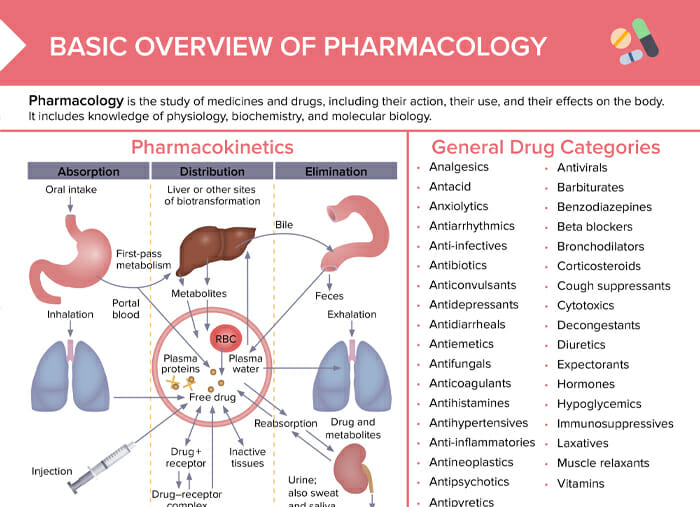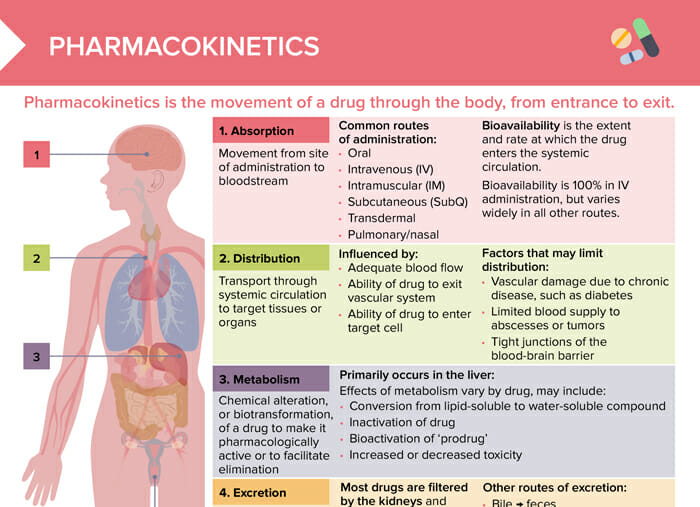What is pharmacokinetics?
Pharmacokinetics is the study of how a drug moves through the body, including processes of absorption, distribution, metabolism, and excretion.
Learning about this is essential for nurses as it helps determine the dosage, administration route, and frequency of medication, considering factors like the client’s age, weight, disease state, and liver and kidney functions, to ensure optimal therapeutic effect and minimize adverse effects.
What are the 4 steps of pharmacokinetics?
- Absorption: movement from site of administration to bloodstream
- Distribution:
- Transport through systemic circulation to target tissues or organs
- Influenced by: blood flow, ability of drug to exit vascular system and to enter target cell
- Limited by: vascular damage (e.g. diabetes), limited blood supply (e.g. tumors), tight junctions of blood–brain barrier
- Metabolism:
- Chemical alteration, or biotransformation, of a drug to make it pharmacologically active or to facilitate elimination
- Occurs mainly in liver
- Effects of metabolism may include:
- Conversion from lipid-soluble to water-soluble compound
- Inactivation of drug
- Bioactivation of ‘prodrug’
- Increased or decreased toxicity
- Excretion:
- Removal of drug from the body
- Most drugs are filtered by kidneys and eliminated in urine. Mind clients with renal disease/kidney failure!
- Other routes of excretion: Bile/feces, lungs, sweat/saliva, breastmilk
How does the absorption process impact drug effect?
The absorption rate determines how fast and how much of the drug reaches the bloodstream and can take effect. It’s affected by factors such as administration route, metabolic rate, and food interactions.
What is “bioavailability?”
Bioavailability is the percentage of the administered drug that reaches the systemic circulation intact (extent and rate at which the drug enters the systemic circulation). It impacts drug efficacy and dosing decisions.
Bioavailability is 100% in IV administration, but varies widely in all other routes.
How does a person’s metabolism influence pharmacokinetics?
Metabolism, mainly in the liver, transforms the drug into a form that can be excreted. Some drugs are activated or deactivated during this phase, influencing drug effect.
What factors can affect drug distribution in the body?
Factors that influence where the drug will take effect include:
- Blood flow
- Fat solubility of the drug
- Protein binding
- Drug’s ability to cross cell membranes and barriers (like the blood-brain barrier)
What is the cytochrome P450 system and why is it important?
The cytochrome P450 system is a group of 12 closely related enzyme families responsible for metabolism of most drugs.
Genetic variability in CYP450 enzyme function contributes to differences in individuals’ ability to metabolize drugs. Many foods and medications can inhibit or induce the CYP450 enzyme system. It is important to counsel clients regarding the potential food and drug interactions of their specific medications.
What is the “first pass effect?”
The “first pass effect” refers to the fact that drugs that are administered orally and absorbed from the gastrointestinal tract are first transported to the liver and metabolized there, before entering the systemic circulation.
This can significantly decrease bioavailability and therefore must be considered when determining the appropriate dosage for oral medications.

